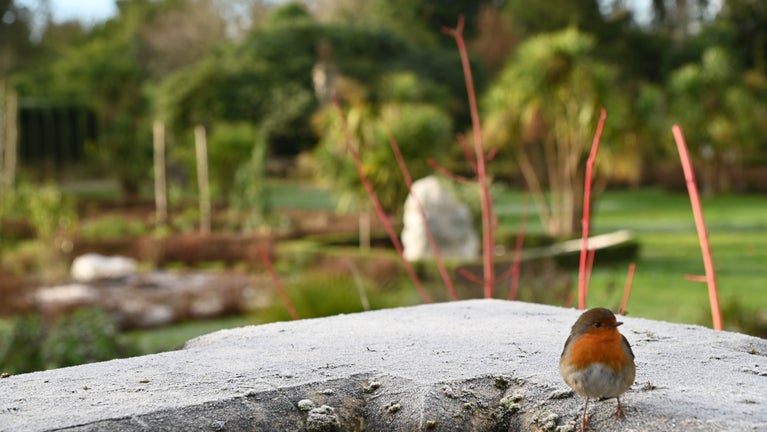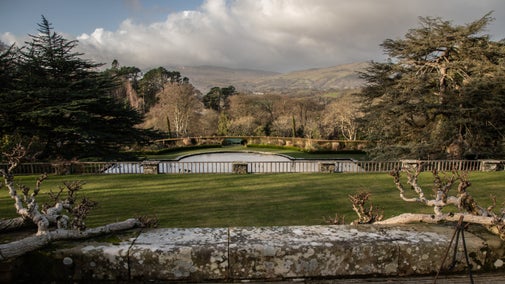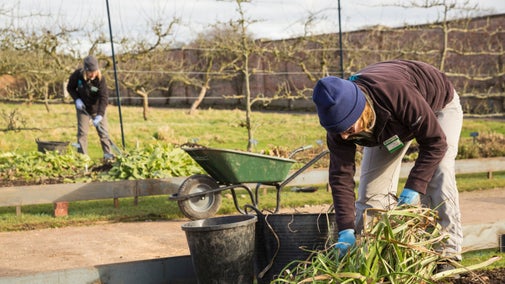
Discover more at Mount Stewart
Find out when Mount Stewart is open, how to get here, things to see and do and more.

Take a stroll through the world-class gardens at Mount Stewart and discover an extraordinary plant collection and original, historic features. The garden at Mount Stewart is truly unique, and with so many elements to explore including a Shamrock Garden, intriguing sculptures and flowering blooms, there are plenty of things to see and do.
The Mount Stewart microclimate allows plants to grow here that are not found anywhere else on this latitude. Some of the plants that we grow need a little help making it through winter so you may see them covered up, but there are many other brave and hardy plants that you can seek out and enjoy in the winter garden.
See pops of colour from the late flowering winter blooms including dusty pinks, buttered yellows, golds, oranges, and blood reds. And take in the seasonal scents floating through the garden, ranging from sweet and fruity perfumes, to powerfully spicy and exotic aromas. Head to the walls of the Sunk Garden to find the winter daisy that has a liquorice scent to some and the smell of cherry pie to others.
Soak up unique views of Mount Stewart house from across the lawn of the Sunk Garden. Designed by Edith, Lady Londonderry to relate directly with the ground floor of the house, the planting is based on a sketch in one of nine garden notebooks dated 1922.
Spot carefully sculpted topiary in the Shamrock Garden. Cut into the Shamrock hedge you can find creatures from Irish mythology, characters from a children’s story and figures inspired by Mary Queen of Scot’s prayer book. The artist and family friend Edmund Brock is also depicted holding a bottle of whisky.

Take a look at the statues positioned in the Italian Garden, and spot figures from Greek mythology depicted on the Southern Wall. Edith, Lady Londonderry was known by friends as Circe, the sorceress goddess in Homer's Odyssey. In the Odyssey, Circe turns half of Odysseus’ crew into pigs and in the Italian Garden you can find statuary depicting their faces and that of Circe on the herms on the southern wall. The planting is derived from an article Lady Londonderry wrote for the RHS Journal in 1935.
Discover intriguing sculptures which reveal the stories of Edith, Charles, their family and friends. Dotted about the garden you’ll find many creations in concrete, stone and topiary.
Crafted into the concrete you can spot animals from the ‘Ark’, a weekly social gathering held by Edith and Charles during the dark days of the First World War, where members took on pseudonyms which were usually a pun on their name.
Charles for example, became Charley the Cheetah – he was tall and elegant and as sleek as a cat, and his infidelities were also an open secret; whilst his cousin Winston Churchill became Winston the Warlock.
The Dodos refer to Edith’s father who was caricatured as such after serving 35 years in the House Commons in 1903. Thomas Beattie created most of the remarkable sculptures around the garden, including the tall herm pillars topped with orangutans, which Edith adapted from the classical versions at the Villa Farnese at Caprarola near Rome.
Below the orangutans are men’s faces, and careful observation shows that each one becomes more pig-like.
Take a stroll past the tall walls of cypress hedges designed by Edith, Lady Londonderry, and explore the Spanish Garden, which was inspired by an early 16th-century description of the Garden of Generalife near Granada.
The blue and green colour palette is based on the hue of the Casita tiles and the salmon-pink limestone of the decorative well head, which was bought by Edith at the RHS Chelsea Flower Show in 1926.
Wander through the Mairi Garden, bursting with blue and white flowers designed to reflect the emblem of the Women’s Legion, a voluntary organisation founded and directed by Edith, Lady Londonderry during the First World War.
The bronze statue commemorates the birth of Lady Mairi in 1921, surrounded by bells and cockle shells based on the nursery rhyme.
At the top of the lake walk you can follow the path leading to what was once the Rose Garden, Dairy and Vinery. The Walled Garden combined two of Edith, Lady Londonderry’s passions, the desire for scents and perfume within the garden and healthy eating.
The Vinery which is under long term refurbishment is home to a very significant vine, ‘White Syrian’, (planted only one year after the oldest vine in the UK, the Hampton Court Vine, planted in 1768), making it beyond doubt the oldest vine in Ireland. In recent years the Rose Garden has been restored to its former glory and is the perfect place to sit back and revel in nature.

Find out when Mount Stewart is open, how to get here, things to see and do and more.
Discover Mount Stewart with your dog. With acres of parkland to explore there's plenty of space for them to bound, sniff, jump and splash. Mount Stewart is a two pawprint rated place.

Explore the historic house and wander through the elegant rooms to discover a much-loved family home, filled with magnificent portraits and personal treasures.

Pull on your walking boots, choose your route and head out for a walk on the Mount Stewart estate. Spot seasonal wildlife as you go, or run wild in the natural play area.

Home to the Londonderry family for generations, uncover the stories of the people who lived and worked at Mount Stewart

Discover more about the women of Mount Stewart from leading the Women’s Legion, using their influence with Parliament and hosting visits from royalty.

From 18th-century water gardens and Arts and Crafts landscapes to intimate woodland gardens, there are so many places to discover.

Discover our gardeners’ top tips so you can make the most of your garden, plot or window box.
